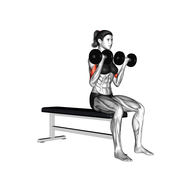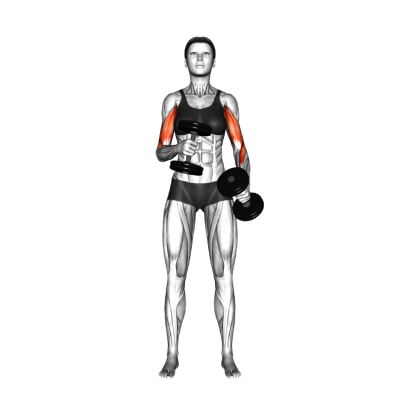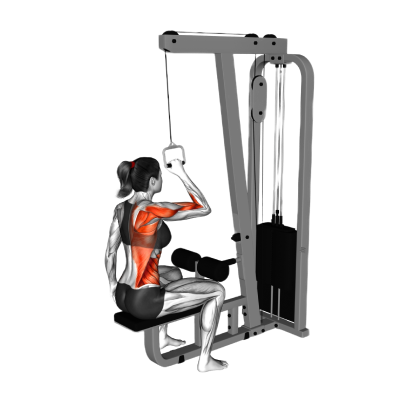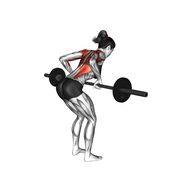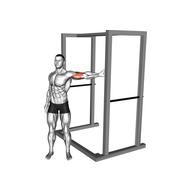Alternating Incline Dumbbell Curl
Alternating incline dumbbell curls are a bicep curl variation that you do sitting on an incline bench. The best incline bench angle for this curl is 45 degrees. It puts your arms behind your body, so your biceps get more of a stretch and an extended range of motion. To do this exercise, hold a dumbbell in each hand, facing your palms forward. Alternate curling one dumbbell at a time towards your body, letting the other arm hang down below your bench. Alternating incline dumbbell curls are a powerful exercise for both the long and short heads of your biceps. They put slightly more emphasis on the long head (the part at the outside of your arm when your palms face up) since the angle you use extends your range of motion. It’s an excellent way to build strength and a good bicep peak exercise to create more volume in your upper arms.
How-to
- Sit on an incline bench with a dumbbell in each hand, arms extended down by your sides, with palms facing forward.
- Keeping your elbows tucked by your sides, raise your right arm towards your shoulder. Squeeze and hold.
- Lower the dumbbell back to the starting position, and repeat with the other arm.
Muscle Worked
Primary Muscle Groups


Biceps
The biceps are muscles that sit at the front or your upper arms between your elbows and shouldersSecondary Muscle Groups


Forearms
The forearms help you grip objects and move your hands, wrists and fingersPro Tips
- Start by Flexing. Your Wrists Before you curl, add a slight flex of your wrist at the “down” position of the exercise when your arms are hanging by your sides. It’s a small but powerful way to enhance your curls. This micro movement engages your forearms more and helps create a better connection with your biceps. Starting your curl from here primes your muscles to contract more fully.
- Control Your Negative (Eccentric Phase). You’re probably thinking about the “up” portion of your lift on a curl— hoisting your dumbbell up toward your body. But slowing down the lowering phase (eccentric phase) is something many of us tend to overlook. Try to control the lowering action of your dumbbell, timing it out to about a 3-4 second lower time on each rep. This increases the time under tension for your biceps. This puts more stress on your bicep muscle fibers, forcing the muscles to grow and build endurance over time.
Equipments
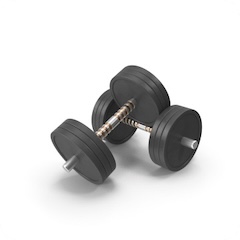
Dumbbell
Dumbbells are hand-gripped bars loaded with equal weight on both ends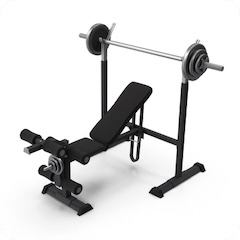
Incline Bench
The incline bench is a variation of the traditional bench that is tilted at a 45-degree angleBenefits
- The key benefit of working on an incline is that it allows for a deeper stretch across your biceps at the bottom of the movement. In a traditional curl, it’s not as easy to get this stretch since your range of motion is more limited. Extending the range helps to recruit more muscle fibers, especially your biceps’ long head. If you’re focused on aesthetic workouts for arm definition, targeting the long head can help create a higher bicep peak.
- Unlike your standing or seated curls, using an incline bench helps keep your shoulders and upper body more stable. In turn, they don’t involve themselves as much in alternating incline dumbbell curls. The muscular isolation you create when your shoulders are still letting your biceps do almost all the work. The shoulders don’t kick in to compensate so you may see better bicep growth over time by favoring this curl variation over traditional bicep curls.
Variations
The following exercises target the same primary muscles using the same equipment:
Alternatives
The following exercises target the same primary muscles using different equipment:
Warm Up & Cool Down
Warm Up
- Arm Circles- Make big circles with your arms in one direction, then the other to warm up your arm and shoulder joints. This will help get your blood pumping and activate your mobility before you curl.
- Intro Curl Set- Activate your biceps with a few light, bodyweight curls or resistance band curls. You’ll start to initiate the curling motion but you won’t max out your efforts by using a heavy load here.
- Shoulder Shrugs- Hold a light weight or no weight at all, and shrug your shoulders toward your ears. Lower them slowly. This helps to warm up your trapezius muscles and shoulders. Ideally, we want these areas to stay still when we’re curling, but it’s useful to understand what these muscles feel like when they’re active so we can reduce their involvement when it comes to working with heavier weights.
Cool Down
- Bicep Stretch- Stick one arm out in front of you with your palm facing up. Pull your fingers back gently to stretch your bicep.
- Tricep Stretch- Reach one arm over your head. Bend your elbow to touch the opposite shoulder blade, and use the other hand to try to gently push the bent elbow down. This balances your stretch between biceps, triceps and shoulders to cool your whole upper body down after a bicep-focused workout.
- Wrist Stretch- Come onto all fours, bringing your shoulders over your wrists. Externally rotate your arms so your fingers face back toward your body, then lean your hips back, trying to sit on your heels. This provides a deep stretch that relieves your wrists of their efforts during alternating incline dumbbell curls.
FAQ


Get fit with Flex
Build muscle & lose weight fast for free.
Available on iPhone + Apple Watch

